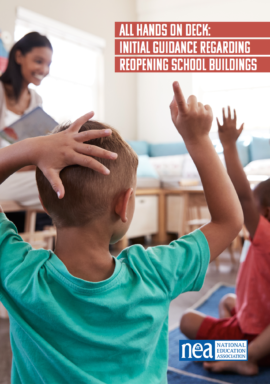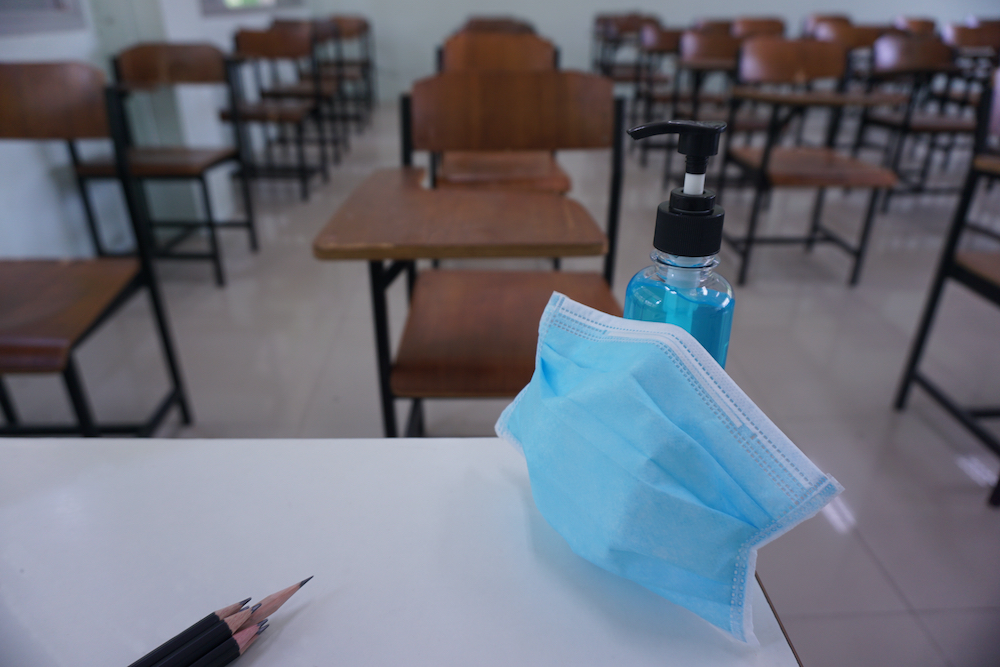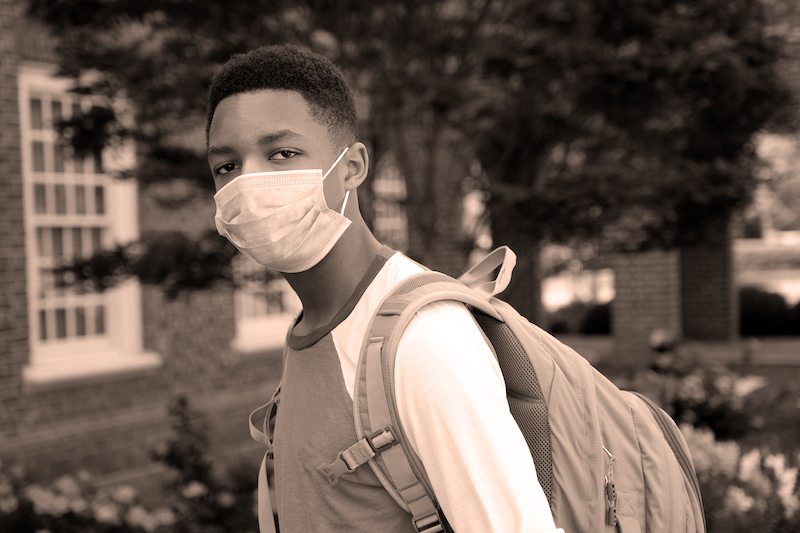Many schools across the country will in all likelihood reopen in the fall for the 2020-21 school year. States are currently reviewing potential models that maximize both learning - whether in-person or continued remote instruction - and health and safety. Still, because of continued uncertainty surrounding the coronavirus pandemic, "back to school" for many districts and college campuses remains more of an “if” than a “when.”
As some states are currently discovering, reopening plans that ignore or downplay the advice of scientists and public health experts can backfire. In K-12 and higher ed buildings, a poorly designed and executed strategy can cost lives, particularly among our most vulnerable students and in communities of color, or at the very least further jeopardize their educational progress.
The National Education Association (NEA) believes that any reopening model has to not only ensure the health and safety of students and staff, but also prioritize long term strategies on student learning and educational equity.
 To assist states and school districts in this effort, NEA this week released "All Hands on Deck: Initial Guidance Regarding Reopening School Buildings." Built around four basic principles - health expertise, educator voice, access to protection, and leading with equity - the document lays out what schools need to do to prepare for reopening, and how they can make their reopening succeed far beyond the first few weeks of the new school year.
To assist states and school districts in this effort, NEA this week released "All Hands on Deck: Initial Guidance Regarding Reopening School Buildings." Built around four basic principles - health expertise, educator voice, access to protection, and leading with equity - the document lays out what schools need to do to prepare for reopening, and how they can make their reopening succeed far beyond the first few weeks of the new school year.
"We have a unique opportunity" the guidance says, "to create schools and campuses that are unequivocally resolute in their commitment to student learning, beacons of service and partnership to communities, and respected and sought-after institutions of employment. The aim is not adequacy; rather, it is productive excellence for all."
The challenges are formidable, but the guidance underscores the opportunity to learn from events, not only from the Spring, but also from the previous decade. "All Hands on Deck" pinpoints specific actions states, districts, and schools can take to promote equity, health, and safety, and avoid the ruinous budget cuts that crippled public schools after the Great Recession.
"The American economy cannot recover if schools can’t reopen," said NEA President Lily Eskelsen García. "And we cannot properly reopen schools if funding is slashed and students don’t have what they need to be safe, learn and succeed."
The Pandemic’s Continuing Fallout
By the end of March, COVID-19 had forced public schools in 48 states and the District of Columbia to close. Students and educators transitioned - practically overnight - to online distance learning.
Despite the momentous efforts of educators during the pandemic, online learning has never been an effective replacement for in-person learning and support. And the pandemic has highlighted the vast inequalities of the U.S. educational system, particularly severe in rural areas and communities of color.
 (Photo: Shutterstock)
(Photo: Shutterstock)
Too many students were not getting the instruction they needed, exacerbated by inadequate access to the necessary technology. Furthermore, the critical services and supports schools provide - daily nutrition, emotional and mental health - made the loss of school from their daily lives all the more glaring.
Testifying on Capitol Hill on Monday before the House Committee on Education and Labor, NEA Vice-President Becky Pringle said, "Under the bright, flashing lights of COVID-19, we can no longer turn away from the fact that not all students have access to the educators, resources, and tools they need. The pandemic’s continuing fallout could make inequities far worse....The nation cannot ignore the opportunity to help ensure that the students who will be returning to their school buildings all return to equitable and just - and safe - educational experiences."
Re-Evaluating Priorities
In addition to the urgency around equity, NEA's guidance is also rooted in health expertise, educator voice, and access to protection.
NEA believes the federal guidelines on reopening schools (issued on a basic flow-chart) in May are vague and inadequate. Accordingly, state and local governments should listen closely to science and public health experts for more specific guidance. "All Hands on Deck" identifies several necessary preconditions for reopening, including increased COVID-19 testing and contact tracing.
Once schools are marked for reopening, districts should then spare no effort to equip them with all the necessary Personal Protective Equipment (PPE) and disinfectants to keep students and staff safe. When education support professionals (ESPs) in Donna, Texas reported back to work in May, they were met at the door by the school nurse who took their temperature but did not provide them with face masks. The ESPs immediately demanded the district address these gaping holes in the protocols and supply the necessary PPE.
As schools formulate their plans around reopening, this strong educator voice and expertise will be indispensable - before, during, and after schools reopen.
 "States and districts must acknowledge that the pandemic was not experienced equally by all communities and populations, particularly in rural areas and communities of color. These systems must evaluate how different families handled the time out of school buildings." - All Hands on Deck, National Education Association (Photo: Getty Images)
"States and districts must acknowledge that the pandemic was not experienced equally by all communities and populations, particularly in rural areas and communities of color. These systems must evaluate how different families handled the time out of school buildings." - All Hands on Deck, National Education Association (Photo: Getty Images)
As the #RedforEd protests have demonstrated so powerfully over the past two years, educator voice can bring about real positive change in how the nation invests in its schools. The economic crisis triggered by the COVID-19 pandemic jeopardizes that progress, even threatening a calamitous return to the austerity measures that crippled schools following the Great Recession a decade ago.
COVID-19 has already done more damage in three months than a recession that lasted for a year and a half. If this damage goes unchecked, nearly 2 million educators—one-fifth of the workforce—could lose their jobs over the next three years.
"Our priorities as a nation must be re-evaluated," NEA's guidance says. A failure to learn from past mistakes and ignore the urgent funding needs of K-12 schools and higher education, "would lead to various problems that will prolong the current economic crisis, including increased class sizes, educator job losses, reduced resources and opportunities for student learning, and potential impacts on school infrastructure."
Educators and parents are demanding that Congress pass the HEROES Act, which provides $200 billion to fill state and local budget gaps, including funds for PPE and narrowing the digital divide. In addition, more than 800,000 education jobs could be saved—more than 673,000 K-12 and 153,000 higher ed jobs.
"By investing in our educators, our public schools, and institutions of higher education," NEA's guidance says, "We will emerge with stronger, more resilient, and more racially and socially just communities. Public schools and public institutions are a driving force in our nation’s recovery because a school is at the heart of every community."






